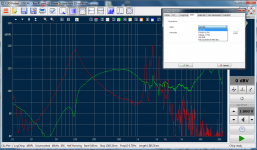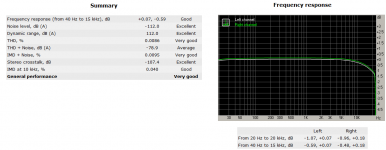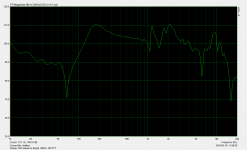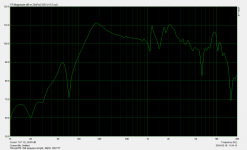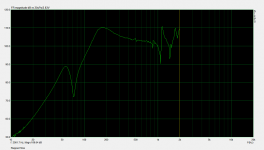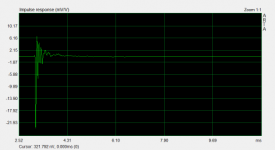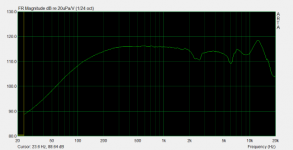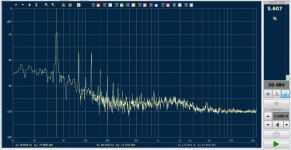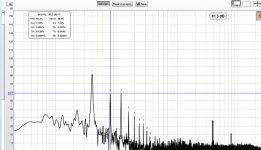Yes, all can be done in CLIO Pocket.
Near-filed of port (red) and near-field of driver (green) . Math processing: dB shift the port then add the shifted port data to driver data. The result is near-field of low-frequency response.
You can see MIB in Math as well processing. I don't use it, but near field.
Near-filed of port (red) and near-field of driver (green) . Math processing: dB shift the port then add the shifted port data to driver data. The result is near-field of low-frequency response.
You can see MIB in Math as well processing. I don't use it, but near field.
Attachments
Yes, all can be done in CLIO Pocket.
Near-filed of port (red) and near-field of driver (green) . Math processing: dB shift the port then add the shifted port data to driver data. The result is near-field of low-frequency response.
You can see MIB in Math as well processing. I don't use it, but near field.
Ok, thank you. I do not know exactly why, but below 30 - 40 Hz is information poor. A similar situation exists in Arta, therefore I used Step with step sine.
For example, when I used REW and sequence lenght is 1M, resolution is same like with step sine.
I think , longer sequences would only help.
Ok, thank you. I do not know exactly why, but below 30 - 40 Hz is information poor. ...
I think , longer sequences would only help.
Yes, longer sequence and longer frame will absolutely help.
Just a few AP-S1 measurements of my CLIO Pocket.
AP-S1 sampling frequency was 48 kHz. AUX input was connected to CLIO Pocket output.
The bar shows THD+N of 1 kHz, 1 V output.
Right most figure shows background noise level measured by using bandpass filter of AP.
Excellent,but please see the recording soundcard belowGood hearing is not equivalent to good-look parameters,vice versa!But bad-looking specifications is not indeed pleasant to hear.
Attachments
Last edited:
Excellent,but please see the recording soundcard belowGood hearing is not equivalent to good-look parameters,vice versa!But bad-looking specifications is not indeed pleasant to hear.
Sorry for my ignorance but if you use curve A in a test
You have a drastic cut off from 300 htz and lower frec.
And is usefull only if you test a speaker near to mic at low level ( 60 to 75 dbpr) to try ( only try) to mimic human hear at most
These king off test cover any problem in a low frec range off the test equipment
Is beter if you use a C curve to test acoustic in a moderate to hi level ( normal )
75 to 95 dBpr for testing and curve Z or flat to test equipement
Santiago
Ok, thank you. I do not know exactly why, but below 30 - 40 Hz is information poor. A similar situation exists in Arta, therefore I used Step with step sine.
For example, when I used REW and sequence lenght is 1M, resolution is same like with step sine.
I think , longer sequences would only help.
You experience room modes and low-frequency noise (e.g. fan, air cond.) in low-freq. region. This is the reason to use near-field method to measure low-freq response.
You can simply take measurements without having excitation signal to see those effects (measuring environmental noise).
Last edited:
Anyone willing to sell there Clio Pocket system? Out of stock at parts express. In need of one ASAP.
Martin
I purchased my CLIO Pocket from a dist. in UK. I can PM you the contact if it is useful.
Ordered one from germany. Should arrive in next few days.
Thanks
Thanks
I purchased my CLIO Pocket from a dist. in UK. I can PM you the contact if it is useful.
You experience room modes and low-frequency noise (e.g. fan, air cond.) in low-freq. region. This is the reason to use near-field method to measure low-freq response.
You can simply take measurements without having excitation signal to see those effects (measuring environmental noise).
I understand what is it measuring the near field, but I write that met on longer sequences than 65K and of course the longer window, just for the sake of better information.
I understand what is it measuring the near field, but I write that met on longer sequences than 65K and of course the longer window, just for the sake of better information.
Today I played a bit with near-field measurements in Arta.
The best result I achieved with PN Pink.
Sequence lenght 256K, sampling frequence 96kHz, and FFT size is 16K.
Sweep it is absolutely useless at just any settings.
I wonder at what settings can be achieved solid results in a nearby field in Clio.
Any graphs?
I also used Arta sweep, MLS and PN before having CLIO Pocket. No problem for me at all. Sweep/LogChirp is still my first choice.
BTW, Pocket provides 16384 or 65536 for chirp.
On Wednesday I send , I have more time .
I assume that near-field measurements of 16,384 would be better sample has been 65k and 48 kHz, rather better to measure the room ...
As I wrote , I gained ideal case with a 16k and 96 kHz. Near-field measurements should be clearly defined, outside of parasitic reflections in the bottom of the zone, but sampel that you sent me, shows under 30-40 Hz anomaly...
okI measured a small speaker (post #81) which has a roll-off around 100 Hz. Output from the speaker was so low that room effect and ambient noise dominated the data.
I measured a small speaker (post #81) which has a roll-off around 100 Hz. Output from the speaker was so low that room effect and ambient noise dominated the data.
I ask you , if you'll take a moment time , try to do some more solid measurement with Clio.
Thank you
I used to use ARTA Sweep to make near/far-field measurement with encountering any issue. Below figures show impulse response and corresponding frequency response of a near-field measurement.
Can you show impulse response of each test?
Can you show impulse response of each test?
Attachments
THD meter vs FFT
I just realized that the CLIO Pocket THD-% or THD-dB meter seems to take only second harmonic in to account. It is shown in the figure below. FFT of the waveform clearly show equal level second and third harmonic. Higher harmonics are also not weak. CLIO Pocket THD-% meter shows 5.607 %. This is lower than that measured by REW RTA as shown in the next figure. REW shows THD = 10 %.
In CLIO Pocket, I exported the signal in to a wav file. The wav was analyzed in Matlab by the thd function. Result indicated the THD-% (dB) meter of CLIO Pocket only uses second harmonic in calculation.
I just realized that the CLIO Pocket THD-% or THD-dB meter seems to take only second harmonic in to account. It is shown in the figure below. FFT of the waveform clearly show equal level second and third harmonic. Higher harmonics are also not weak. CLIO Pocket THD-% meter shows 5.607 %. This is lower than that measured by REW RTA as shown in the next figure. REW shows THD = 10 %.
In CLIO Pocket, I exported the signal in to a wav file. The wav was analyzed in Matlab by the thd function. Result indicated the THD-% (dB) meter of CLIO Pocket only uses second harmonic in calculation.
Attachments
I used to use ARTA Sweep to make near/far-field measurement with encountering any issue. Below figures show impulse response and corresponding frequency response of a near-field measurement.
Can you show impulse response of each test?
I do not have impulse when I have some time , I try it again and submit . It was my intention to make me perform better in Clio , well below 30 Hz , for example REW works perfectly in a nearby field .
As I expressed THD is insufficient information , especially when it's only the second harmonic
- Home
- Design & Build
- Equipment & Tools
- CLIO Pocket
